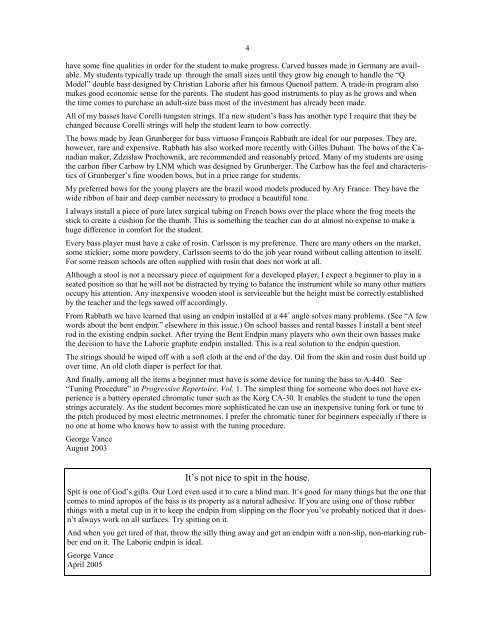Reader No 1 - Slava Publishing
Reader No 1 - Slava Publishing
Reader No 1 - Slava Publishing
Create successful ePaper yourself
Turn your PDF publications into a flip-book with our unique Google optimized e-Paper software.
4<br />
have some fine qualities in order for the student to make progress. Carved basses made in Germany are available.<br />
My students typically trade up through the small sizes until they grow big enough to handle the “Q<br />
Model” double bass designed by Christian Laborie after his famous Quenoil pattern. A trade-in program also<br />
makes good economic sense for the parents. The student has good instruments to play as he grows and when<br />
the time comes to purchase an adult-size bass most of the investment has already been made.<br />
All of my basses have Corelli tungsten strings. If a new student’s bass has another type I require that they be<br />
changed because Corelli strings will help the student learn to bow correctly.<br />
The bows made by Jean Grunberger for bass virtuoso François Rabbath are ideal for our purposes. They are,<br />
however, rare and expensive. Rabbath has also worked more recently with Gilles Duhaut. The bows of the Canadian<br />
maker, Zdzislaw Prochownik, are recommended and reasonably priced. Many of my students are using<br />
the carbon fiber Carbow by LNM which was designed by Grunberger. The Carbow has the feel and characteristics<br />
of Grunberger’s fine wooden bows, but in a price range for students.<br />
My preferred bows for the young players are the brazil wood models produced by Ary France. They have the<br />
wide ribbon of hair and deep camber necessary to produce a beautiful tone.<br />
I always install a piece of pure latex surgical tubing on French bows over the place where the frog meets the<br />
stick to create a cushion for the thumb. This is something the teacher can do at almost no expense to make a<br />
huge difference in comfort for the student.<br />
Every bass player must have a cake of rosin. Carlsson is my preference. There are many others on the market,<br />
some stickier, some more powdery. Carlsson seems to do the job year round without calling attention to itself.<br />
For some reason schools are often supplied with rosin that does not work at all.<br />
Although a stool is not a necessary piece of equipment for a developed player, I expect a beginner to play in a<br />
seated position so that he will not be distracted by trying to balance the instrument while so many other matters<br />
occupy his attention. Any inexpensive wooden stool is serviceable but the height must be correctly established<br />
by the teacher and the legs sawed off accordingly.<br />
From Rabbath we have learned that using an endpin installed at a 44˚ angle solves many problems. (See “A few<br />
words about the bent endpin.” elsewhere in this issue.) On school basses and rental basses I install a bent steel<br />
rod in the existing endpin socket. After trying the Bent Endpin many players who own their own basses make<br />
the decision to have the Laborie graphite endpin installed. This is a real solution to the endpin question.<br />
The strings should be wiped off with a soft cloth at the end of the day. Oil from the skin and rosin dust build up<br />
over time. An old cloth diaper is perfect for that.<br />
And finally, among all the items a beginner must have is some device for tuning the bass to A-440. See<br />
“Tuning Procedure” in Progressive Repertoire, Vol. 1. The simplest thing for someone who does not have experience<br />
is a battery operated chromatic tuner such as the Korg CA-30. It enables the student to tune the open<br />
strings accurately. As the student becomes more sophisticated he can use an inexpensive tuning fork or tune to<br />
the pitch produced by most electric metronomes. I prefer the chromatic tuner for beginners especially if there is<br />
no one at home who knows how to assist with the tuning procedure.<br />
George Vance<br />
August 2003<br />
It’s not nice to spit in the house.<br />
Spit is one of God’s gifts. Our Lord even used it to cure a blind man. It’s good for many things but the one that<br />
comes to mind apropos of the bass is its property as a natural adhesive. If you are using one of those rubber<br />
things with a metal cup in it to keep the endpin from slipping on the floor you’ve probably noticed that it doesn’t<br />
always work on all surfaces. Try spitting on it.<br />
And when you get tired of that, throw the silly thing away and get an endpin with a non-slip, non-marking rubber<br />
end on it. The Laborie endpin is ideal.<br />
George Vance<br />
April 2005


